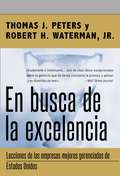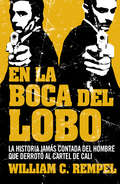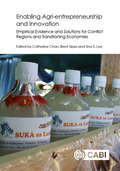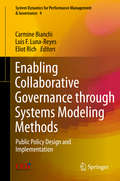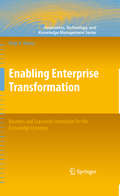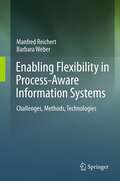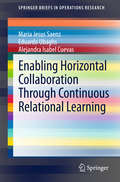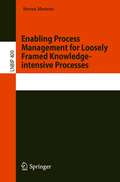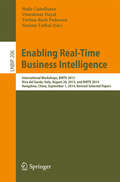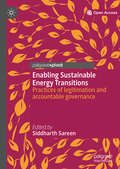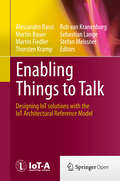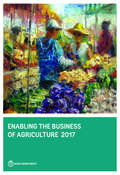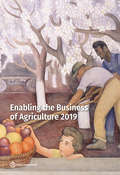- Table View
- List View
En busca de la excelencia
by Tom Peters Robert H. Waterman Jr.El «mejor libro de negocios de todos los tiempos» (Bloomsbury REINO UNIDO), este libro ha sido desde hace mucho tiempo obligatorio en la sala de juntas, la escuela de negocios y la mesa de noche. Basado en un estudio de cuarenta y tres de las empresas mejores administradas de Estados Unidos de una gran variedad de sectores empresariales, este libro describe ocho principios básicos de la gerencia, estimula a la acción, orientado a la gente, prácticas que maximizan los beneficios, que hicieron de estas companías organizaciones exitosas. Este fenomenal best seller dispone de una nueva Nota del autor, y retoma estos principios vitales de manera accesible y práctica para el lector gerencial actual.
En cien años todos muertos: Guía para emprender o morir... sin haberlo hecho
by Joan BoludaEl libro de referencia para los emprendedores. Una guía de supervivencia práctica y amena para emprendedores. Prepara el terreno, empieza a rodar y aborda con éxito el día a día de tu actividad profesional o empresarial. Si estás leyendo esto, quiere decir que dentro de cien años estarás muerto. La vida es terroríficamente corta y cualquier día pensarás: «¿Qué demonios he hecho con mi vida? ¿Por qué no he hecho lo que quería? ¿Por qué he abandonado mis sueños?». Ahora aún estás a tiempo de cambiar, de actuar y de hacer lo que quieres. ¡No esperes más! Si tu trabajo no te realiza, no te hace feliz y estás considerando montar tu propio negocio, pero no te atreves, tienes miedo o no sabes cómo, sigue leyendo. Y si conoces a alguien que esté en esa situación, invítale a leerlo. Le puede ser de mucha ayuda. Porque este es un libro para espíritus emprendedores, desde el autónomo hasta el empresario. Para todas aquellas personas que han sentido esa fuerza, ese «empuje» invisible que te lleva a emprender. Y Joan Boluda, con su amplia experiencia como emprendedor, formador y divulgador, aborda todas aquellas cuestiones que cualquier emprendedor debería saber para emprender sin morir en el intento. De una forma llana y simple desbroza el camino para preparar el terreno, empezar a rodar y abordar el día a día en cualquier negocio o actividad profesional que te propongas. El libro no contiene la fórmula mágica del éxito, ni es un método para triunfar. Pero te animará a emprender si eso es lo que te hace feliz. Te alertará de todo lo que te vas a encontrar si quieres emprender. Te enseñará los conceptos, técnicas y estrategias que mejor resultado dan, para que los conozcas y los apliques. Y te guiará de forma clara y amena para que sepas qué pasos dar cuando empieces esta aventura.
En la boca del lobo: La historia jamás contada del hombre que derrotó al cartel de Cali (Vintage Espanol Ser.)
by William C. Rempe¿Arriesgarías tu vida para salvar tu alma? La historia jamás contada del hombre que derrotó al cartel de Cali. Colombia, en los años noventa, era un país sumido en el caos con un gobierno débil que combatía a la guerrilla y a los narcotraficantes inmersos en una guerra liderada por Pablo Escobar y sus eternos rivales: los hermanos Rodríguez Orejuela, del cartel de Cali. Jorge Salcedo, ingeniero, oficial de la reserva del ejército, un hombre de negocios respetado, padre de familia, que despreciaba a Escobar, entró a formar parte del cartel de Cali para convertirse en el jefe de seguridad de uno de los capos. Salcedo pretendía ignorar la corrupción, la violencia y la brutalidad que lo rodeaba, y luchó por preservar su integridad con grandes dificultades, hasta que un día recibió una orden directa del padrino que no podía cumplir pero tampoco desobedecer. Salcedo comprendió entonces que suúnica salida era traicionar al sindicato del crimen más rico y poderoso de todos los tiempos, arriesgarlo todo e intentar derrotar a los de Cali en un juego a vida o muerte en el que eran muy pocas las posibilidades de ganar. William C. Rempel es el único reportero con acceso directo a Jorge Salcedo y a su historia. Salcedo vive escondido con su familia en algún lugar de Estados Unidos. Nadie, ni siquiera el autor, conoce su paradero. Reseñas:«Un thriller real de ritmo vertiginoso que acelera el corazón.»Kirkus Reviews «Bill Rempel se ha ganado la reputación de mejor reportero de investigación de América, y como los cronistas de antaño, consigue que la gente le cuente historias asombrosas que no revelaría a nadie más. En la boca del lobo pone de manifiesto la maestría de Rempel al desvelar con todo lujo de detalles los secretos de la sangrienta guerra de las drogas en Colombia a partir del testimonio directo de uno de sus principales protagonistas. Al final te das cuenta de que el mayor misterio es que Jorge Salcedo haya logrado sobrevivir el tiempo suficiente para poder contarle su vida a Rempel.»James Risen, autor de Estado de guerra «En este impactante y extraordinario trabajo de no ficción, William Rempel pone de manifiesto la importancia de los reportajes de investigación, logrando acceder a la persona que podría, y de hecho lo hizo, difundir los secretos que desmontaron un cartel tan poderoso como el de Cali. Rempel tiene una historia extraordinaria que contar. No solamente arrastra al lector al oscuro mundo de los carteles de drogas, sino que ofrece también el estudio fascinante de un personaje, un hombre que tendrá que responder a una pregunta terrible: ¿Debe arriesgar su vida para salvar su alma o mantener un pacto con el diablo?»David Grann, autor de La ciudad perdida de Z y El diablo y Sherlock Holmes
En marcha con Uber: On the Move with Uber
by Tom SleeLa verdad sobre cómo actúa e interviene Uber en nuestra sociedad. Que Uber no es una empresa de economía colaborativa es vox populi, pero lo que quizá no sabes es cómo afecta en tu ciudad que esa empresa no pague impuestos en ella, el precario trato que Uber le da a sus conductores y cómo les hace pagar por trabajar, o cómo pueden rastrear tus movimientos en los trayectos. Este breve ensayo sobre Uber nos muestra una realidad escondida tras los bajos precios y el marketing que hace que nos replanteemos si realmente merece la pena utilizar este servicio que si bien nos supone un precio menor como individuos también supone nos supone un coste mayor como sociedad.
En sus trece: Prensa que irrita al poder (2011-2018)
by César Hildebrandt"Porque el periodismo es eso: tensar la cuerda, retar, obtener, tras arduos trabajos, la enemistad de los que cortan el jamón, los muchachos del big money. A mí que no me vengan con prensa sedante, prensa láudano, chicharrón de prensa, mustios collados. Solo la prensa que irrita al poder se salva de envolver pescado." De los muchos textos escritos en estos años para el semanario que lleva mi nombre -groserías del márqueting, demandas de la subsistencia-, pocos son los que resultan legibles con el paso del tiempo. La mayor parte perece en la fugacidad, en el chisporreo grasiento de lo banal. Ahora los leo y me doy cuenta de cuánto reincido en temas y obsesiones. El menú de mi neurosis podría abreviarse de esta manera: me disgusta el mundo tanto como antes, cuando era joven y creía que lo cambiaríamos. Los consejos de la edad no me han servido de nada. Sigo siendo paciente de la ira y está intacto, más lozano si cabe, mi amor por las causas perdidas. Vivo en un país que amo y me abate al mismo tiempo, y he visto caer a casi todos los dioses que fueron el hechizo olimpo de mi juventud. Pero eso no me ha conducido a la melancolía, felizmente. Cada día estoy más convencido de que mi deber es pelear por lo que creo. ¿Creer? Sí, por qué no. No está mal creer que algún día el mundo será verde y que el Perú admitirá el placer de la civilización. No está mal creer que el mundo se deshará de los políticos y reconocerá, a la fuerza, que el planeta merece mejores guías y más ciertos discursos. En el fondo, esa es la pelea. Contra lo que muchos creen, no venero el pesimismo. Admito que el Perú alienta todas las tristezas y los desalientos, pero jamás me entregué al lujo de los años sabáticos y las treguas clínicas. La peor desgracia del Perú son sus políticos. Y eso es algo que hemos permitido los peruanos. No fue el imperialismo el que nos impuso a Fujimori ni vinieron de fuera los alisios viciosos que nos han hecho renunciar, tantas veces, a la dignididad ciudadana. No es de extrañar que buena parte de de estos textos estén dirigidos al denuesto altisonante de quienes asumieron el poder y nos defraudaron. César Hildebrandt
EnClean: Malcolm Waddell's Story (A)
by Elizabeth Johnson David J. CollisDescribes, in the words of its cofounder, the history of EnClean, an industrial and environmental services company, from its origins in 1984. The company grew rapidly and diversified into new businesses and new geographies both through acquisition and internally. It went public in 1989 but then suffered major losses in 1992 and 1993. The founder must now decide how to respond to a secret board ultimatum.
Enable Action: Removing Barriers to Implementing Change
by Dan S. CohenOnce you've given employees a reason to change, you must provide them with the means to make change happen. The purpose of this step in the change process is to enable a broad base of people to take action by removing as many barriers to the implementation of the change vision as possible. This chapter provides practical advice and assessment tools for removing the barriers that block action and encouraging people to take risks and be innovative.
Enablers of Organisational Learning, Knowledge Management, and Innovation: Principles, Process, and Practice of Qualitative Data
by Preethi KesavanThis book establishes constructivist, interpretivist, and linguistic approaches based on conventions about the nature of qualitative and text data, the author’s influence on text interpretation, and the validity checks used to justify text interpretations. Vast quantities of text and qualitative data in organizations often go unexplored. Text analytics outlined in this book allow readers to understand the process of converting unstructured text data into meaningful data for analysis in order to measure employee opinions, feedback, and reviews through sentiment analysis to support fact-based decision making. The methods involve using NVivo and RapidMiner software to perform lexical analysis, categorization, clustering, pattern recognition, tagging, annotation, memo creation, information extraction, association analysis, and visualization. The methodological approach in the book uses innovation theory as a sensitizing concept to lay the foundation for the analysis of research data, suggesting approaches for empirical exploration of organizational learning, knowledge management, and innovation practices amongst geographically dispersed individuals and team members. Based on data obtained from a private educational organization that has offices dispersed across Asia through focus group discussions and interviews on these topics, the author highlights the need for integrating organizational learning, knowledge management, and innovation to improve organizational performance, exploring perspectives on collective relationships and networks, organizational characteristics and structures, and tacit and overt values which influence such innovation initiatives. In the process, the author puts forward a new theory which is built on three themes: relationship and networks, knowledge sharing mechanisms, and the role of social cognitive schema that facilitate emergent learning, knowledge management, and innovation.
Enabling Agri-entrepreneurship and Innovation
by Catherine Chan Brent Sipes Tina S. LeeAgricultural entrepreneurs in conflict and post-conflict regions face special challenges; not just everyday personal risks, but also the difficulties of building small businesses when real or threatened violence can disrupt business growth cycles and economic security. Alongside establishing secure institutions, building a secure economy is rightly seen as the best way for conflict-torn regions to establish a peaceful future. But current agricultural entrepreneurship training and development starts from an assumption of peace, meaning that it is not always fit for purpose. The result is sub-optimal program design and inefficient use of resources. A product of a collaboration of experts in the fields of agri-business, agricultural marketing, and international development, this book gives officials and agencies developing entrepreneurship programs the practical real-life examples they need. Key Features: #65533; Based on research by experienced field practitioners. #65533; Establishes best practice approaches for supporting agri-entrepreneurship in conflict regions. #65533; Range of global case studies to illustrate lessons learnt.
Enabling Business Strategy with IT at the World Bank
by F. Warren McfarlanWorld Bank IT provides services (communications, applications, video conferencing, knowledge sharing, distance learning, information sharing, client commerce, crisis management, etc.) on a global basis to the poorest countries in the globe via satellites. This case covers the bank's global business strategy transformation and the role that IT plays in enabling that vision. Covers strategy and implementation topics and conveys a sense of using IT to narrow the digital divide on a global scale while recapping the evolution of the bank's IT strategy and implementation from 1995 to 2003.
Enabling Collaborative Governance through Systems Modeling Methods: Public Policy Design and Implementation (System Dynamics for Performance Management & Governance #4)
by Luis F. Luna-Reyes Carmine Bianchi Eliot RichThis volume constitutes a first approximation for the use of systems approaches and dynamic performance management as tools for collaborative governance. The chapters examine models and simulations used in some specific systems approaches, which contribute to facilitating problem focus and collective understanding of collaborative governance, especially in the area of performance management. The explicit connection between resources and outcomes promoted by this view helps managers to understand better how to improve policy and to create positive outcomes that create public value.
Enabling Creative Chaos: The Organization Behind the Burning Man Event
by Katherine K. ChenThis book examines the Burning Man organization to show how we have the agency to mold organizational experiences more to our liking.
Enabling Enterprise Transformation
by Nagy K. HannaPrivate enterprises in advanced economies have been learning to use information and communication technology (ICT) to innovate and transform their processes, products, services and business models, significantly improving productivity and competitiveness. Moreover, the ICT industry itself has become a major source of job creation and a contributor to economic growth and business transformation. A key question today is whether and how developing countries can learn to benefit from the ICT revolution, and what roles the government and private sector can play. Already, a number of developing countries have been inspired by the example of India and China, and are now seeking to jump on the outsourcing bandwagon. Nevertheless, with few exceptions in the developing world, little attention has been paid by policymakers and practitioners to invest systematically and proactively in ICT-enabled growth, poverty reduction and grassroots innovation. Most communities and small and medium-sized enterprises in developing countries, for example, face multiple constraints to adopting and leveraging this general purpose technology, and lack the capabilities for maximizing its potential. In "Enabling Enterprise Transformation", Nagy Hanna draws on his rich experience of over 35 years at the World Bank and other aid agencies as a development strategist and ICT policy expert, the most current research, and best practices from around the world to provide practical tools for promoting economic and social transformation through ICT. He assesses various initiatives to develop and diffuse ICT, such as innovation funds, incubators, parks, public-private partnerships, and comprehensive promotion programs. He argues for the strategic options now open for developing countries to participate in ICT production, to deploy ICT to transform industries and services, and to leverage ICT as a new national infrastructure for improving the business environment and enhancing the competitiveness of the whole economy. The challenge for leaders in developing countries is to create such social and institutional dynamics for learning about ICT use and adaptation at many levels. Lessons gained so far from programs to build these social learning and innovation capabilities at the institutional and grassroots levels should be shared among developing countries, and a dialogue among business leaders, policymakers, development agencies, educational institutions, and the general citizenry must be advanced.
Enabling Environment
by Srinivasan SunderasanEnabling Environment is as real as it gets. The global commons are jointly owned and their inhabitants are jointly obligated to ensure their preservation. In the face of protracted negotiations, convoluted documentation, discord, and incessant bickering among scientists, activists, pressure groups of various hues, politicians and negotiators, very often the people on the ground are ignored or taken for granted. In the meantime, life meanders along. It is these 'everyday individuals' who make consumption-related choices on their lifestyles, travel or on preferring certain products or services over others. Enabling Environment puts the individual front and center. Ecosystem services need to be recognized, appropriately priced and the costs allocated to the agents concerned. Enabling Environment is about defining economic and non-economic incentive structures and utilizing them to arrive at pro-environmental outcomes. This collection of articles illustrates the use of existing social, economic and regulatory structures, and the financial architecture and instruments, suitably modified or extended, to help internalize the environmental externality.
Enabling Flexibility in Process-Aware Information Systems: Challenges, Methods, Technologies
by Barbara Weber Manfred ReichertIn today's dynamic business world, the success of a company increasingly depends on its ability to react to changes in its environment in a quick and flexible way. Companies have therefore identified process agility as a competitive advantage to address business trends like increasing product and service variability or faster time to market, and to ensure business IT alignment. Along this trend, a new generation of information systems has emerged--so-called process-aware information systems (PAIS), like workflow management systems, case handling tools, and service orchestration engines. With this book, Reichert and Weber address these flexibility needs and provide an overview of PAIS with a strong focus on methods and technologies fostering flexibility for all phases of the process lifecycle (i.e., modeling, configuration, execution and evolution). Their presentation is divided into six parts. Part I starts with an introduction of fundamental PAIS concepts and establishes the context of process flexibility in the light of practical scenarios. Part II focuses on flexibility support for pre-specified processes, the currently predominant paradigm in the field of business process management (BPM). Part III details flexibility support for loosely specified processes, which only partially specify the process model at build-time, while decisions regarding the exact specification of certain model parts are deferred to the run-time. Part IV deals with user- and data-driven processes, which aim at a tight integration of processes and data, and hence enable an increased flexibility compared to traditional PAIS. Part V introduces existing technologies and systems for the realization of a flexible PAIS. Finally, Part VI summarizes the main ideas of this book and gives an outlook on advanced flexibility issues. The book's target groups include researchers, PhD students and Master students in the field of information systems. After reading the book, they will better understand PAIS flexibility aspects. To support the easy use as a textbook, a series of exercises is provided at the end of each chapter and slides and further teaching material are available on the book's web site www.flexible-processes.com. Professionals specializing in business process management (BPM) who want to obtain a good understanding of flexibility challenges in BPM and state-of-the-art solutions will also benefit from the presentations of open source as well as commercial process management systems and related practical scenarios.
Enabling Horizontal Collaboration Through Continuous Relational Learning
by Maria Jesus Saenz Eduardo Ubaghs Alejandra Isabel CuevasNow that supply chain operations are facing new challenges due to the necessity of reducing costs and CO2 emissions, companies are increasingly leveraging cooperation from companies from other supply chains as a source of competitive advantage. Horizontal Collaboration has been proved an efficient tool for cutting logistic costs up to 49%. Zaragoza Logistics Center, member of the MIT-Scale Network, is publishing this book with the aim of building upon a framework of inter-organizational learning for horizontal collaboration on logistic operations. The outcome of this study is designed to help understand the relationship dynamics and managerial insights of horizontal collaboration for sustainable and profitable cooperation in freight distribution. The proposed collaborative practices are based on senior manager experiences from different industries: home appliances, automotive, retail, and food and beverage. Additionally, collaborative evidence from various successful pilot cases relevant to the distribution operations of the four industries are described, in order to illustrate the framework presented. This book fills a gap in the literature market and its insights encourages the readers to reflect on their own operational circumstances and challenges. Additionally, the book can be used as supplementary reading for master degree courses on supply chain collaboration, as well as courses in executive management.
Enabling Immobilities: Social and Spatial Implications for Urban Planning (SpringerBriefs in Applied Sciences and Technology)
by Giovanni LanzaThis book presents a novel perspective on immobility, a topic often overlooked in urban planning and transport studies. It argues that conceptualizing, measuring, and analyzing the diverse forms in which individual immobilities manifest can provide crucial insights for designing more inclusive and sustainable planning policies. Immobility is here framed as a relative condition, where individuals experience reduced movement across time and space compared to others. While mobility is often seen as essential for social inclusion, this book challenges the notion that immobility is inherently negative. Instead, it positions immobility as not only the result of specific personal or spatial constraints but also as a reversible, voluntary choice to reduce daily travel. This choice can be influenced by the level of accessibility and proximity to valued spatial opportunities and can yield significant socio-environmental benefits. The book introduces an innovative framework that integrates immobility into urban planning theory and practice. Through case studies, it addresses four main operational challenges to foster a deeper understanding of immobility’s social and spatial implications: the measurement of immobility, the analysis of spatial conditions that facilitate chosen immobility, the exploration of the lived experiences of immobility, and the examination of planning policies that can promote reversible immobility to advance social inclusion and sustainability. By examining immobility in both its constrained and reversible forms, the book contributes to broader debates on how to achieve inclusion, sustainability, and accessibility through planning.
Enabling Process Management for Loosely Framed Knowledge-intensive Processes (Lecture Notes in Business Information Processing #409)
by Steven MertensThis book is a revised version of the PhD dissertation written by the author at the Department of Business Informatics and Operations Management at Ghent University in Belgium.It addresses shortcomings in Business Process Management concerning loosely framed knowledge-intensive processes, which are characterized by their numerous valid process variants and their reliance on knowledge workers to apply their knowledge to decide on a suitable process variant that fits the context of a specific process execution. The goal was to lay the foundation for a process-aware business process management (IT-)system to support such processes. Several proof-of-concept implementations have been made for the core components and were evaluated in the domain of the healthcare. Starting from an artificial, but realistic, case about patients that arrive in the emergency room with suspected arm fractures and later progressing to a case study of the diagnosis and treatment of patients in the emergency department of a real hospital, using data from their patient files. In 2020, the PhD dissertation won the “CAiSE PhD award”, granted to outstanding PhD theses in the field of Information Systems Engineering.
Enabling Real-Time Business Intelligence
by Malu Castellanos Umeshwar Dayal Torben Bach Pedersen Nesime TatbulThis book constitutes the thoroughly refereed conference proceedings of the 7th International Workshop on Business Intelligence for the Real-Time Enterprise, BIRTE 2013, held in Riva del Garda, Italy, in August 2013 and of the 8th International Workshop on Business Intelligence for the Real-Time Enterprise, BIRTE 2014, held in Hangzhou, China, in September 2014, in conjunction with VLDB 2013 and 2014, the International Conference on Very Large Data Bases. The BIRTE workshop series provides a forum for the discussion and advancement of the science and engineering enabling real-time business intelligence and the novel applications that build on these foundational techniques. This volume contains five full, two short, and two demo papers, which were carefully reviewed and selected with an acceptance rate of 45%. In addition, one keynote and three invited papers are included.
Enabling Sustainable Energy Transitions: Practices of legitimation and accountable governance
by Siddharth SareenThis open access book reframes sustainable energy transitions as being a matter of resolving accountability crises. It demonstrates how the empirical study of several practices of legitimation can analytically deconstruct energy transitions, and presents a typology of these practices to help determine whether energy transitions contribute to sustainability.The real-world challenge of climate change requires sustainable energy transitions. This presents a crisis of accountability legitimated through situated practices in a wide range of cases including: solar energy transitions in Portugal, urban energy transitions in Germany, forestland conflicts in Indonesia, urban carbon emission targets in Norway, transport electrification in the Nordic region, and biodiversity conservation and energy extraction in the USA. By synthesising these cases, chapters identify various dimensions wherein practices of legitimation construct specific accountability relations. This book deftly illustrates the value of an analytical approach focused on accountable governance to enable sustainable energy transitions. It will be of great use to both academics and practitioners working in the field of energy transitions.
Enabling Things to Talk
by Martin Bauer Alessandro Bassi Martin Fiedler Thorsten Kramp Rob Kranenburg Sebastian Lange Stefan MeissnerThe Internet of Things (IoT) is an emerging network superstructure that will connect physical resources and actual users. It will support an ecosystem of smart applications and services bringing hyper-connectivity to our society by using augmented and rich interfaces. Whereas in the beginning IoT referred to the advent of barcodes and Radio Frequency Identification (RFID), which helped to automate inventory, tracking and basic identification, today IoT is characterized by a dynamic trend toward connecting smart sensors, objects, devices, data and applications. The next step will be "cognitive IoT," facilitating object and data re-use across application domains and leveraging hyper-connectivity, interoperability solutions and semantically enriched information distribution. The Architectural Reference Model (ARM), presented in this book by the members of the IoT-A project team driving this harmonization effort, makes it possible to connect vertically closed systems, architectures and application areas so as to create open interoperable systems and integrated environments and platforms. It constitutes a foundation from which software companies can capitalize on the benefits of developing consumer-oriented platforms including hardware, software and services. The material is structured in two parts. Part A introduces the general concepts developed for and applied in the ARM. It is aimed at end users who want to use IoT technologies, managers interested in understanding the opportunities generated by these novel technologies, and system architects who are interested in an overview of the underlying basic models. It also includes several case studies to illustrate how the ARM has been used in real-life scenarios. Part B then addresses the topic at a more detailed technical level and is targeted at readers with a more scientific or technical background. It provides in-depth guidance on the ARM, including a detailed description of a process for generating concrete architectures, as well as reference manuals with guidelines on how to use the various models and perspectives presented to create a concrete architecture. Furthermore, best practices and tips on how system engineers can use the ARM to develop specific IoT architectures for dedicated IoT solutions are illustrated and exemplified in reverse mapping exercises of existing standards and platforms.
Enabling the Business of Agriculture 2017
by World Bank GroupEnabling the Business of Agriculture 2017, the third report in the series, offers insights into how laws and regulations affect private sector development for agribusinesses, including producer organizations and other agricultural entrepreneurs. Globally comparable data and scored indicators encourage regulations that ensure the safety and quality of agricultural inputs, goods and services but are not too costly or burdensome. The goal is to facilitate the operation of agribusinesses and allow them to thrive in a socially and environmentally responsible way, enabling them to provide essential agricultural inputs and services to farmers that could increase their productivity and profits. Regional, income-group and country-specific trends and data observations are presented for 62 countries and across 12 topics: seed, fertilizer, machinery, finance, markets, transport, water, ICT, land, livestock, environmental sustainability and gender. Data are current as of June 30, 2016. For more information, please see http://eba.worldbank.org
Enabling the Business of Agriculture 2019
by World Bank GroupEnabling the Business of Agriculture 2019 presents indicators that measure the laws, regulations and bureaucratic processes that affect farmers in 101 countries. The study covers eight thematic areas: supplying seed, registering fertilizer, securing water, registering machinery, sustaining livestock, protecting plant health, trading food and accessing finance. The report highlights global best performers and countries that made the most significant regulatory improvements in support of farmers.
Enabling the Internet of Value: How Blockchain Connects Global Businesses (Future of Business and Finance)
by Paolo Tasca Jiahua Xu Nikhil VadgamaThis book shows how blockchain technology can transform the Internet, connecting global businesses in disruptive ways. It offers a comprehensive and multi-faceted examination of the potential of distributed ledger technology (DLT) from a new perspective: as an enabler of the Internet of Value (IoV). The authors discuss applications of blockchain technology to the financial services domain, e.g. in real estate, insurance and the emerging Decentralised Finance (DeFi) movement. They also cover applications to the media and e-commerce domains. DLT’s impacts on the circular economy, marketplace, Internet of Things (IoT) and oracle business models are also investigated. In closing, the book provides outlooks on the evolution of DLT, as well as the systemic governance and privacy risks of the IoV. The book is intended for a broad readership, including students, researchers and industry practitioners.
